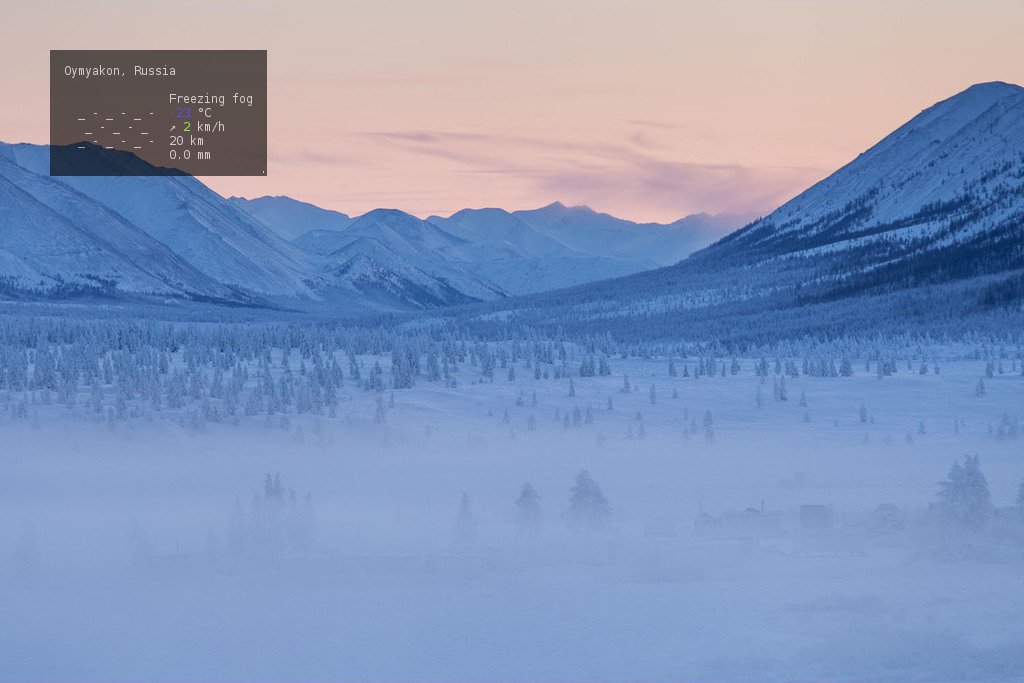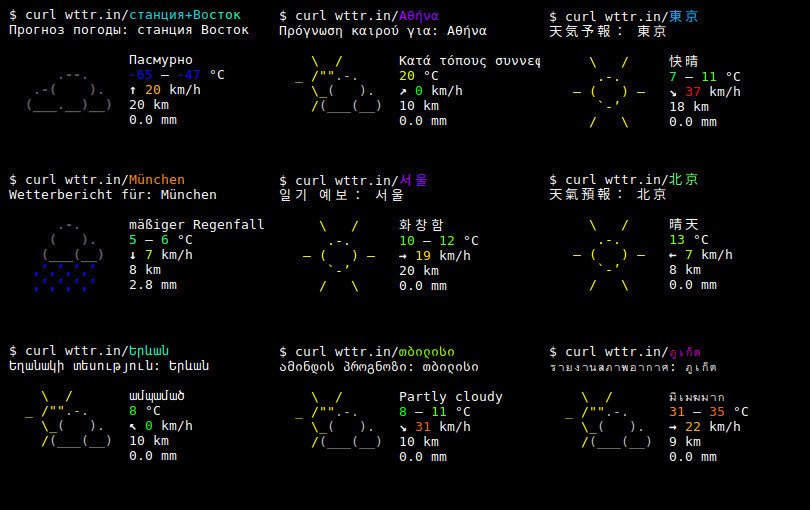wttr.in — the right way to check the weather!
wttr.in is a console-oriented weather forecast service that supports various information representation methods like terminal-oriented ANSI-sequences for console HTTP clients (curl, httpie, or wget), HTML for web browsers, or PNG for graphical viewers.
wttr.in uses wego for visualization and various data sources for weather forecast information.
You can see it running here: wttr.in.
You can access the service from a shell or from a Web browser like this:
$ curl wttr.in
Weather for City: Paris, France
\ / Clear
.-. 10 – 11 °C
― ( ) ― ↑ 11 km/h
`-’ 10 km
/ \ 0.0 mm
Here is an actual weather report for your location (it's live!):
(It's not your actual location - GitHub's CDN hides your real IP address with its own IP address, but it's still a live weather report in your language.)
Want to get the weather information for a specific location? You can add the desired location to the URL in your request like this:
$ curl wttr.in/London
$ curl wttr.in/Moscow
If you omit the location name, you will get the report for your current location based on your IP address.
Use 3-letter airport codes in order to get the weather information at a certain airport:
$ curl wttr.in/muc # Weather for IATA: muc, Munich International Airport, Germany
$ curl wttr.in/ham # Weather for IATA: ham, Hamburg Airport, Germany
Let's say you'd like to get the weather for a geographical location other than a town or city - maybe an attraction
in a city, a mountain name, or some special location. Add the character ~ before the name to look up that special
location name before the weather is then retrieved:
$ curl wttr.in/~Vostok+Station
$ curl wttr.in/~Eiffel+Tower
$ curl wttr.in/~Kilimanjaro
For these examples, you'll see a line below the weather forecast output that shows the geolocation results of looking up the location:
Location: Vostok Station, станция Восток, AAT, Antarctica [-78.4642714,106.8364678]
Location: Tour Eiffel, 5, Avenue Anatole France, Gros-Caillou, 7e, Paris, Île-de-France, 75007, France [48.8582602,2.29449905432]
Location: Kilimanjaro, Northern, Tanzania [-3.4762789,37.3872648]
You can also use IP-addresses (direct) or domain names (prefixed with @) to specify a location:
$ curl wttr.in/@github.com
$ curl wttr.in/@msu.ru
To get detailed information online, you can access the /:help page:
$ curl wttr.in/:help
By default the USCS units are used for the queries from the USA and the metric system for the rest of the world.
You can override this behavior by adding ?u or ?m to a URL like this:
$ curl wttr.in/Amsterdam?u
$ curl wttr.in/Amsterdam?m
wttr.in currently supports three output formats:
- ANSI for the terminal;
- ANSI for the terminal, one-line mode;
- HTML for the browser;
- PNG for the graphical viewers.
The ANSI and HTML formats are selected basing on the User-Agent string.
The PNG format can be forced by adding .png to the end of the query:
$ wget wttr.in/Paris.png
You can use all of the options with the PNG-format like in an URL, but you have
to separate them with _ instead of ? and &:
$ wget wttr.in/Paris_0tqp_lang=fr.png
Useful options for the PNG format:
tfor transparency (transparency=150);- transparency=0..255 for a custom transparency level.
Transparency is a useful feature when weather PNGs are used to add weather data to pictures:
$ convert source.jpg <( curl wttr.in/Oymyakon_tqp0.png ) -geometry +50+50 -composite target.jpg
In this example:
source.jpg- source file;target.jpg- target file;Oymyakon- name of the location;tqp0- options (recommended).
For one-line output format, specify additional URL parameter format:
$ curl wttr.in/Nuremberg?format=3
Nuremberg: 🌦 +5⁰C
Available preconfigured formats: 1, 2, 3, 4 and custom format using a percent notation.
wttr.in can also be used to check the phase of the Moon. This example shows how to see the current Moon phase:
$ curl wttr.in/Moon
Get the Moon phase for a particular date by adding @YYYY-MM-DD:
$ curl wttr.in/Moon@2016-12-25
The Moon phase information uses pyphoon as its backend.
wttr.in supports multilingual locations names that can be specified in any language in the world (it may be surprising, but many locations in the world don't have an English name).
The query string should be specified in Unicode (hex-encoded or not). Spaces in the query string
must be replaced with +:
$ curl wttr.in/станция+Восток
Weather report: станция Восток
Overcast
.--. -65 – -47 °C
.-( ). ↑ 23 km/h
(___.__)__) 15 km
0.0 mm
The language used for the output (except the location name) does not depend on the input language
and it is either English (by default) or the preferred language of the browser (if the query
was issued from a browser) that is specified in the query headers (Accept-Language).
The language can be set explicitly when using console clients by using command-line options like this:
curl -H "Accept-Language: fr" wttr.in
http GET wttr.in Accept-Language:ru
The preferred language can be forced using the lang option:
$ curl wttr.in/Berlin?lang=de
The third option is to choose the language using the DNS name used in the query:
$ curl de.wttr.in/Berlin
wttr.in is currently translated into 54 languages, and the number of supported languages is constantly growing.
See /:translation to learn more about the translation process, to see the list of supported languages and contributors, or to know how you can help to translate wttr.in in your language.
To install the application:
- Install external dependencies
- Install Python dependencies used by the service
- Get a WorldWeatherOnline API Key
- Configure wego
- Configure wttr.in
- Configure the HTTP-frontend service
wttr.in has the following external dependencies:
After you install golang, install wego:
$ go get -u github.com/schachmat/wego
$ go install github.com/schachmat/wego
Python requirements:
- Flask
- geoip2
- geopy
- requests
- gevent
If you want to get weather reports as PNG files, you'll also need to install:
- PIL
- pyte (>=0.6)
- necessary fonts
You can install most of them using pip.
If virtualenv is used:
$ virtualenv ve
$ ve/bin/pip install -r requirements.txt
$ ve/bin/pip bin/srv.py
Also, you need to install the geoip2 database. You can use a free database GeoLite2 that can be downloaded from (http://dev.maxmind.com/geoip/geoip2/geolite2/).
To get a WorldWeatherOnline API key, you must register here:
https://developer.worldweatheronline.com/auth/register
After you have a WorldWeatherOnline key, you can configure wego:
$ cat ~/.wegorc
{
"APIKey": "00XXXXXXXXXXXXXXXXXXXXXXXXXXX",
"City": "London",
"Numdays": 3,
"Imperial": false,
"Lang": "en"
}
The City parameter in ~/.wegorc is ignored.
Configure the following environment variables that define the path to the local wttr.in
installation, to the GeoLite database, and to the wego installation. For example:
export WTTR_MYDIR="/home/igor/wttr.in"
export WTTR_GEOLITE="/home/igor/wttr.in/GeoLite2-City.mmdb"
export WTTR_WEGO="/home/igor/go/bin/wego"
export WTTR_LISTEN_HOST="0.0.0.0"
export WTTR_LISTEN_PORT="8002"
It's recommended that you also configure the web server that will be used to access the service:
server {
listen [::]:80;
server_name wttr.in *.wttr.in;
access_log /var/log/nginx/wttr.in-access.log main;
error_log /var/log/nginx/wttr.in-error.log;
location / {
proxy_pass http://127.0.0.1:8002;
proxy_set_header Host $host;
proxy_set_header X-Real-IP $remote_addr;
proxy_set_header X-Forwarded-For $remote_addr;
client_max_body_size 10m;
client_body_buffer_size 128k;
proxy_connect_timeout 90;
proxy_send_timeout 90;
proxy_read_timeout 90;
proxy_buffer_size 4k;
proxy_buffers 4 32k;
proxy_busy_buffers_size 64k;
proxy_temp_file_write_size 64k;
expires off;
}
}


